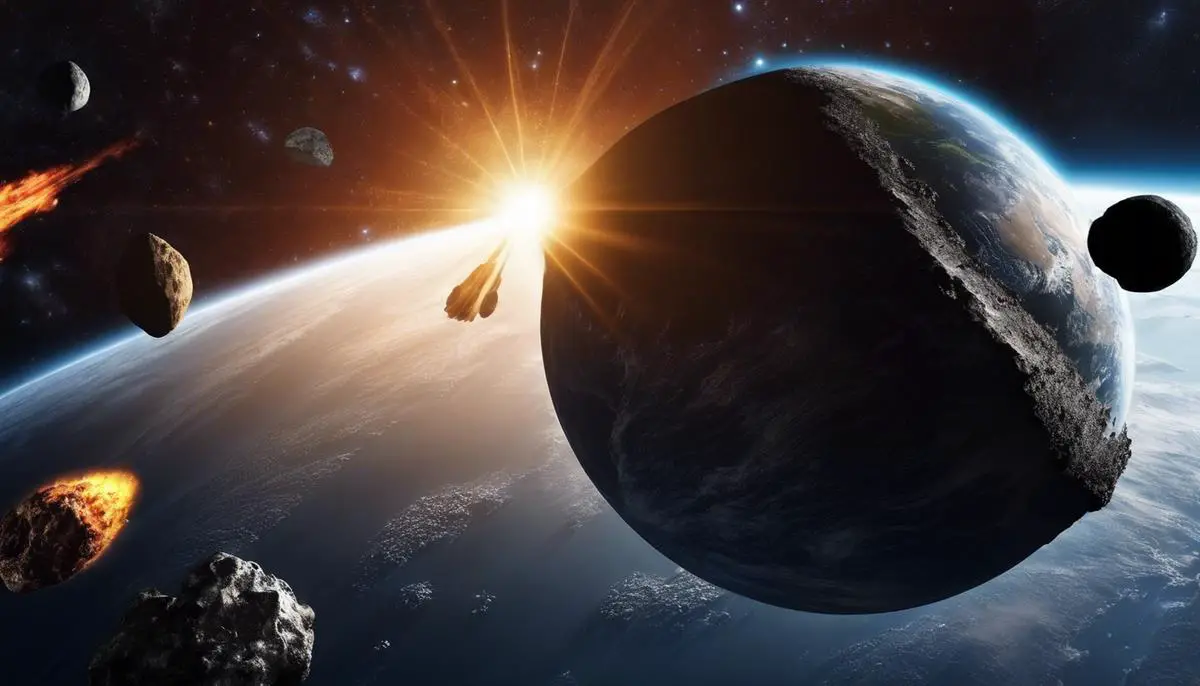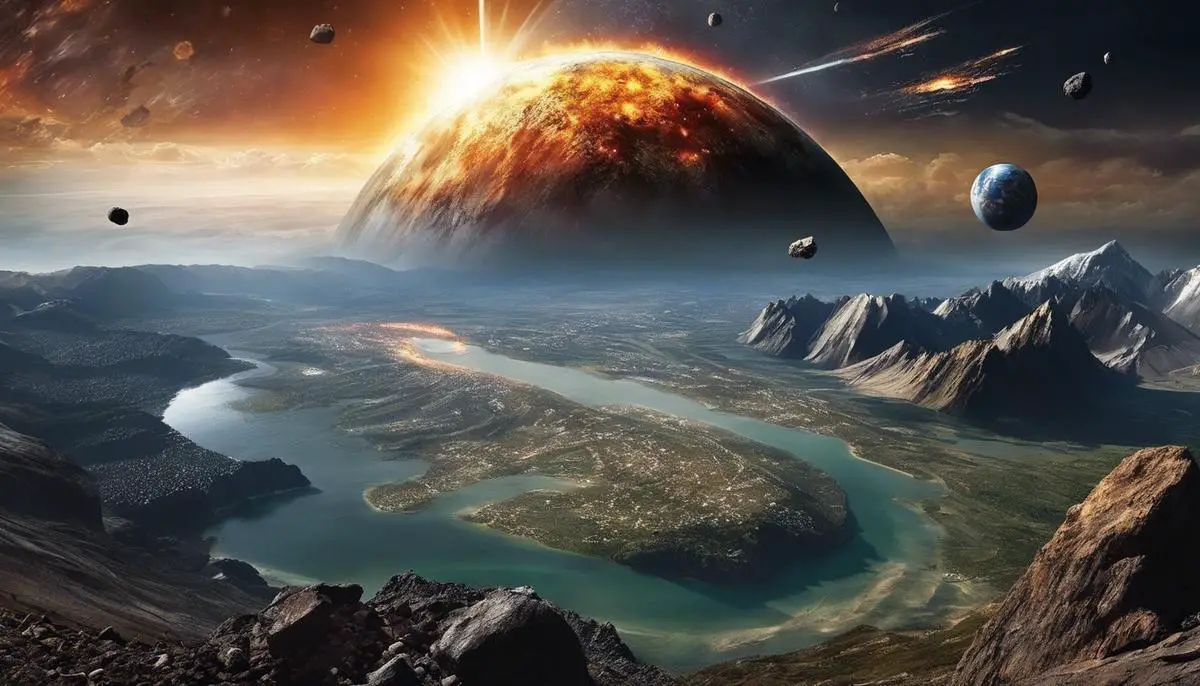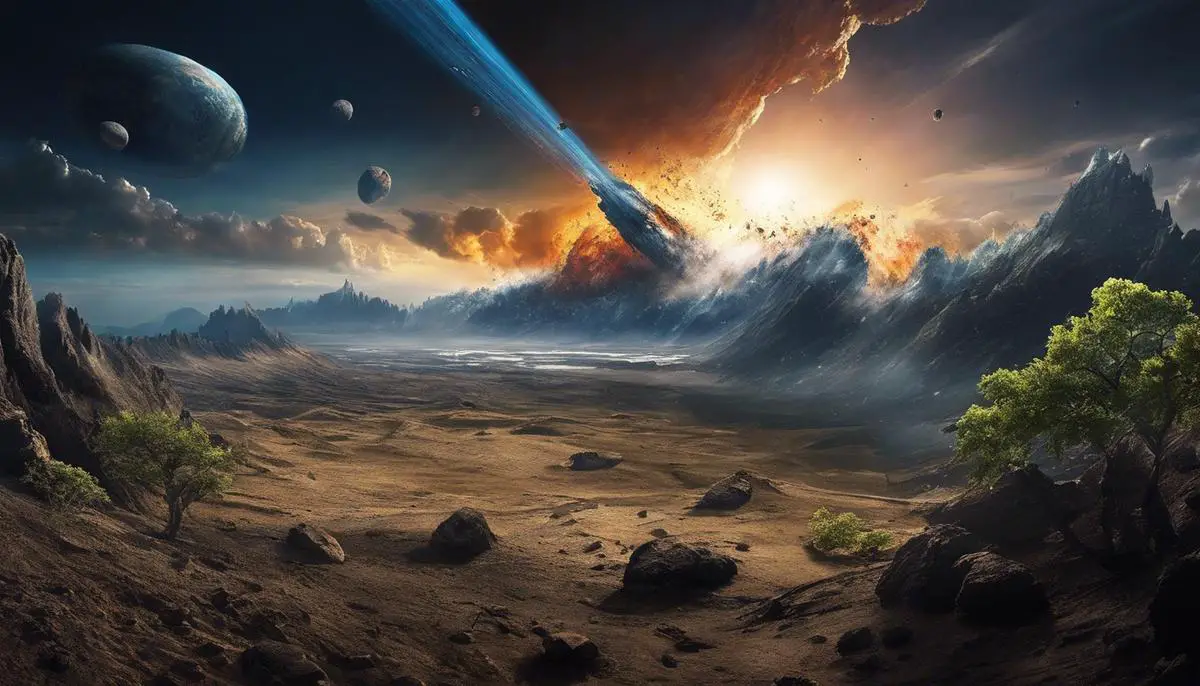Our home planet, Earth, exists in a cosmic shooting gallery, subject to the whims of celestial objects like asteroids and comets. These celestial interactions have played a pivotal role in shaping the development of Earth and its inhabitants through time. This compelling narrative commences with understanding the frequency and sizes of asteroid impacts, which range from inconsequential micrometeors to life-altering celestial behemoths. Beyond coup de grace, asteroid impacts leave lasting marks on the planet’s life, landscape, and atmosphere, fostering global changes as immediate as wildfires, earthquakes and tsunamis, and as persistent as climate shifts. The interplay of asteroid impacts and Earth’s biological evolution paints a fascinating picture, revealing how these cosmic events have fueled the churn of evolution and extinction. In the face of these asteroid threats, humanity stands poised with scientific advancements, prepared to predict, and if necessary, intervene, to secure the future of life on Earth.
Understanding Asteroid Impact Events: Frequencies and Sizes
Earth, Asteroids, and Cosmic Encounters: A Quantitative Overview
Studying celestial bodies is a fascinating endeavor teeming with breathtaking revelations and paradigm-shifting enigmas. In this context, one topic of particular interest is the interaction of Earth with asteroids, these complex, rock-like structures orbiting our sun. Not simplistic by any means, this intersection of planetary geology and celestial mechanics addresses essential questions and expands human understanding of the universe.
On average, Earth is bombarded by 17-18 tons of meteorite material each day, derived predominantly from small asteroids. These celestial bodies typically disintegrate upon contact with Earth’s dense atmosphere, causing the brilliant phenomenon of shooting stars.
However, it is crucial to recognize larger asteroids capable of surviving the scorching journey through Earth’s atmosphere and impacting the surface. These events are less frequent but carry significant implications, ranging from localized damage to global climate change and mass extinctions in pivotal moments of Earth’s history.
Statistical projections, derived from observation data cover the past three decades, denote that approximately once a year an automobile-sized asteroid enters Earth’s atmosphere, generating an impressive fireball but disintegrating before reaching the surface. Larger impacts, with asteroids approximately the size of a football field, occur roughly once every 2,000 years. The aftermath of such encounters can cause serious regional damage.
We should spare a thought for the distinct class of asteroids, those that exceed 1 kilometer in diameter. These substantial cosmic entities are thankfully scarce, with estimated arrival intervals on the scale of hundreds of thousands to millions of years. Impact events involving such giants have global implications, changing the course of evolution and leading, potentially, to mass extinction events.
Regardless of size, all asteroid impacts contribute to a richer understanding of our cosmic neighborhood and its history. They offer tangible evidence of the dynamic nature of solar system evolution, and the continuing interplay of celestial bodies over vast timescales. These extraordinary events offer a uniquely interdisciplinary arena, linking astronomy, geology and planetary science with the ultimate quest for human comprehension of all cosmic processes that shape our existence on this celestial sphere we call Earth.

Assessing the Global Effects of Asteroid Impacts
Potential Global Aftermath and Implications of Large-Scale Asteroid Impacts
It is irrefutable that asteroids have played a significant role in Earth’s history- both shaping its evolution and imparting valuable knowledge around the complexities of our Solar System. When envisioning large-scale asteroid impacts, it becomes vital to discuss the potential aftermath and further global implications. The enormity of such an event would fundamentally alter the planet at mechanistic, climatic, and biological levels.
At the highest level, these asteroid impacts have the ability to reshape our land masses. Large asteroids striking Earth could generate sufficient force to cause seismic activity and large-scale tectonic shifts. In the case of oceanic impacts, colossal tsunamis are expected, altering coastal landscapes and disrupting marine ecosystems.
From a climatic perspective, a severe asteroid event would cast vast amounts of Earth’s crust into the atmosphere, blocking sunlight from reaching the surface. This phenomenon, often referred to as an “Impact Winter,” would drastically lower global temperatures. A drop in sunlight could limit photosynthesis, leading to a decline in primary productivity and triggering possible mass extinction in ecosystems around the world.
Moreover, it’s important not to overlook the potential atmospheric changes. Large amounts of debris projected into the stratosphere could react with ozone molecules, leading to a faster depletion of the ozone layer. This chain reaction would increase the exposure of surface life to harmful ultraviolet radiation from the Sun.
Similarly, on an evolutionary timescale, increased mutation rates could result, potentially leading to new evolutionary trajectories for surviving organisms. These heightened mutation rates could provide the raw material for natural selection, impacting the trajectory of biodiversity and the course of evolution on Earth.
Perhaps even more concerning is the prospect of our planet’s ecosystem shifting irreversibly following a large-scale asteroid impact. History stands as testament to this – the late Cretaceous Meteroid Impact, primarily blamed for the extinction of the dinosaurs, serves as an eery reminder of the possible consequences of extensive asteroid impacts on Earth.
It’s evident that the potential aftermath of large-scale asteroid impacts is immense and multidimensional, influencing not just our natural environment, but evolutionary processes, and global climatic systems as well. This reinforces the importance of research efforts centered towards studying asteroids, preparing for possible impact events, and enhancing our understanding of these celestial bodies. For humanity, gaining more knowledge about asteroids and their effects could contribute to our survival and the safeguarding of our besieged planet.

Asteroid Impacts and Earth’s Biological Evolution
Plunging into the depth of space and time, we navigate through the mysteries of asteroid impacts and their consequential effects on the evolution of life on Earth. While previous sections have evaluated these flashy, violent events through the lens of astronomy, geology, and atmospheric dynamics, we now turn our attention towards the less immediate, yet profound biological ramifications.
A sudden celestial collision sends ripples of force across the globe, propagating a cascade of environmental changes; yet the impact is not limited to the physical dimension; its echo reverberates through the biological realm too. As evidence suggests, enormous asteroid impacts have punctuated the timeline of life on Earth, accentuating points of evolutionary change and species turnover.
Delving into the Carboniferous period, a notable age dominated by large insects and flourishing vegetation, ornithine decarboxylase research indicates that an asteroid impact might have contributed to the rise of oxygen levels. Such an influx would have created an evolutionary pressure, sparking speciation and an adaptive sweep towards superior biological structures.
Probing even further into prehistory, during the world of Permian mass extinction, a period that witnessed the death of nearly 90% of marine species and 70% of terrestrial species, one cannot ignore the role of asteroid impacts. Geological markers such as shocked quartz and elevated levels of iridium, typically found within meteorites, subtly point towards an asteroid related upheaval. This catastrophic event surely opened up ecological niches, leading the way for new species to arise, most significantly, the mighty dinosaurs.
Speaking of dinosaurs, their downfall often captures our imaginations. The famous Chicxulub impact crater in Mexico serves as a grim remembrance of the fate they encountered. Its corresponding timing with the Cretaceous-Paleogene (K-Pg) boundary unequivocally marks a pivotal point in biological evolution. The annihilation of non-avian dinosaurs invoked an evolutionary power play, providing mammals an opportunity to seize control. Tiny early mammals, once relegated to nocturnal existence, emerged triumphant in the post-impact world, evolving rapidly into a plethora of forms, ultimately shaping the diverse fauna we have today, including humans.
Surveying the course of our illustrious planetary history, there is an undeniable scaffold of causal pathways connecting asteroid impacts to biological evolution. Impact events act as catalysts, toppling ecological dominos that create ripples of change across the biosphere. They precipitate extinctions, which no doubt cast a long shadow of death, yet within that shadow lay the seeds of new life, bidding their time to break out and bloom in the wake of disaster.
Reflecting on this riveting chronicle of life shaped by extraterrestrial intrusions, one cannot escape the tantalising question: what future lies in store for our species amidst the continued threat of these cosmic trespassers?
We must continue to gaze skywards, sharpening our understanding of “the heavens” to protect our home, the Earth. Only by wielding the bulwark of knowledge can we hope to confront the challenges posed by these celestial voyagers and ensure the continued saga of our own evolution.

Future Implications: Predicting and Mitigating Asteroid Threats
Embarking on a journey into space, where celestial bodies often pose threat to life on Earth, demands understanding how to predict and minimize potent future asteroid impacts. These pursuits are essential, backed by the potent, transformative power asteroids have demonstrated upon colliding with Earth. Discovering and scrutinizing these celestial objects forms a prime path towards securing our planet’s well-being.
A cornerstone of studying potential asteroid impacts lies in detecting Near-Earth Objects (NEOs) – Comets and asteroids nudged by gravity into orbits entering Earth’s neighborhood. Observatories equipped with telescopes across the globe tirelessly watch the skies. They use computer-based algorithms to identify any unusual movement that could suggest an asteroid’s approach. These observations can then be used to calculate the asteroid’s size, velocity, and trajectory.
Space programs worldwide like NASA’s Planetary Defense Coordination Office, the European Space Agency’s Space Situational Awareness programme, or Japan’s JAXA, put significant effort into NEO observations. NEOs of potentially high-consequence are given due attention, especially those larger than 140 meters, as these can cause significant damage at an impact region.
Radar observation is another critical weapon in asteroid detection. Arecibo Observatory and NASA’s Goldstone Solar System Radar are among the pioneers in radar study of asteroids. Radar measurements help determine an asteroid’s exact location and velocity, making it possible to predict a future close approach or impact event with unparalleled accuracy.
Our endeavor to prevent potential asteroid impacts isn’t limited to just watching the skies. Mankind also makes strides to deflect disastrous asteroids, turning science fiction into reality. These cosmic shields are manifested in space mission concepts, such as NASA’s DART (Double Asteroid Redirection Test), designed to change an asteroid’s motion in space by crashing into it purposefully.
Another asteroid deflection mechanism is the Gravity Tractor method. Here a spacecraft flying alongside an asteroid for an extended period uses its gravitational pull to subtly change the asteroid’s path. These ground-breaking proposals underscore humanity’s proactive approach to addressing astronomic threats.
The strategic placement of an early detection system, coupled with a potential deflection mechanism, may form mankind’s best defense against asteroid impacts. Yet, the key to a deeper understanding of asteroids lies not just in our potential for preventing disaster, but also in the message these celestial envoys bring along.
Asteroids, the remnant debris from our solar system’s formation, are in essence time capsules. Their study contributes to our understanding of how planets, including Earth, came into existence. Space missions like NASA’s OSIRIS-REx, and Japan’s Hayabusa missions, aim to bring back samples from asteroids to Earth. These particles, unchanged for billions of years, may help unravel the mysteries of solar system formation and evolution, illuminating humanity’s place in the cosmos’s grand tapestry.
Every celestial object, every fragment of cosmic dust, uncovers a story about our universe. Though asteroids may pose an ominous threat, scrutinizing their behaviors, understanding their trajectories, and decoding the secrets they harbor could not only safeguard our present, but shine a light on our past, thus providing a roadmap for aspiring astronomers and eager scientists in the generations to come. Always aspiring to the stars, we continue this endeavor with unwavering enthusiasm and caution, watching, learning, and preparing for whatever the cosmos may throw at us.

The Earth’s narrative is written on a cosmic scale where asteroid impacts play integral episodes. They punctuate the swift progress of biological evolution with a cataclysmic exclamation, mark the ends of eras, and trace the beginning of new chapters. From the microscopic dust that rain daily upon our planet’s surface, to the life-altering colossi that have triggered mass extinctions and climate change, these celestial interlopers morph Earth’s history and future. As we look towards the horizon, with an awareness of the potential threats and the technological tools at our disposal, the power to shift from passive recipients to active participants in this cosmic narrative grows. We examine our past to prepare for the future, learning from each asteroid impact event to predict impending strikes and formulate strategies to divert or mitigate catastrophe, thus securing a sustained trajectory for our planet and its life.
![]()
